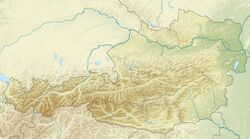Earth:Gosau Group
| Gosau Group Stratigraphic range: Late Cretaceous-Eocene ~90–50 Ma | |
|---|---|
 Rocks of the Gosau Group exposed in the Imster Muttekopf | |
| Type | stratigraphic group |
| Sub-units |
|
| Overlies | Unconformity with folded and faulted Permian to Lower Cretaceous rocks |
| Thickness | 2,200–2,600 m (7,200–8,500 ft) |
| Location | |
| Coordinates | [ ⚑ ] : 47°36′N 13°30′E / 47.6°N 13.5°E |
| Paleocoordinates | [ ⚑ ] 32°06′N 15°36′E / 32.1°N 15.6°E |
| Region | Central Europe |
| Country | Austria Germany Slovakia |
| Extent | Gosau Basin, Limestone Alps |
The Gosau Group (German: Gosau-Gruppe) is a geological stratigraphic group in Austria, Germany and western Slovakia whose strata date back to the Late Cretaceous to Eocene.[1][2] It is exposed in numerous sporadic isolated basins within the Northern Calcareous Alps. It is divided into two subgroups, the Lower Gosau Subgroup which dates from the Turonian to Campanian, approximately 90 to 75 Ma and the Upper Gosau Subgroup which dates to the Santonian to Eocene, about 83.5 to 50 Ma. The formations within each subunit vary significantly between basins. The sequence is largely marine, but the Grünbach Formation represents a terrestrial deposit. Many of the units of the group are fossiliferous, typically providing marine fossils such as ammonites, though terrestrial remains including those of dinosaurs are known from the Grünbach Formation and Schönleiten Formation.
Fossil content
Among others, the following fossils have been described from the Gosau Group:[3][4]
| reptiles | |||||
|---|---|---|---|---|---|
| Genus | Species | Presence | Notes | Images | |
| Struthiosaurus | S. austriacus | Niederösterreich, Austria | [5] | ||
| Mochlodon | M. suessi | A rhabdodontid iguanodont[5] | |||
| Rhadinosaurus | R. alcinus | Possible indeterminate ankylosaur remains[5] | |||
| "Crataeomus" | C. lepidophorus | Later found to be synonymous with Struthiosaurus austriacus[5] | |||
| C. pawlowitschii | Later found to be synonymous with Struthiosaurus austriacus in partim[5] | ||||
| "Danubiosaurus" | D. anceps | Later found to be indeterminate ankylosaurian and Struthiosaurus austriacus remains in partim[5] "Indeterminate fragments"[6] |
|||
| "Hoplosaurus" | H. ischyrus | Later found to be synonymous with Struthiosaurus austriacus[5] | |||
| "Leipsanosaurus" | L. noricus | Later found to be synonymous with Struthiosaurus austriacus[5] | |||
| "Pleuropeltus" | P. suessi | Later found to be synonymous with Struthiosaurus austriacus in partim[5] | |||
| "Megalosaurus" | M. pannoniensis | Later found to be indeterminate theropod remains[5] | |||
| Ornithocheiridae indet. | [7][8] | ||||
| Mollusca | |||||
| Genus | Species | Presence | Notes | Images | |
| "Trochactaeon" | T. conicus' | Nördliche Kalkalpen, Niederösterreich, Austria | Very common fossil, rock forming | File:Trochactaeon conicus.tif | |
See also
- List of dinosaur-bearing rock formations
References
- ↑ Höfling, 1985
- ↑ McCann, 2008
- ↑ Gosau Group at Fossilworks.org
- ↑ Lower Gosau Group at Fossilworks.org
- ↑ 5.0 5.1 5.2 5.3 5.4 5.5 5.6 5.7 5.8 5.9 Weishampel, 2004, pp. 588-593
- ↑ "Table 17.1," in Weishampel et al., 2004, p.367
- ↑ Zitteliana
- ↑ Agnolin & Varricchio, 2012
Bibliography
- Agnolin, Federico L., and David Varricchio. 2012. Systematic reinterpretation of Piksi barbarulna Varricchio, 2002 from the Two Medicine Formation (Upper Cretaceous) of Western USA (Montana) as a pterosaur rather than a bird. Geodiversitas 34. 883–894. Accessed 2013-01-15. doi:10.5252/g2012n4a10
- Höfling, R. 1985. Faziesverteilung und Fossilvergesellschaftungen im karbonatischen Flachwasser-Milieu der alpinen Oberkreide (Gosau-Formation). Münchner Geowissenschaftliche Abhandlungen Reihe A: Geologie und Paläontologie 3. 1–241.
- McCann, T. 2008. The Geology of Central Europe- Volume 2 Mesozoic and Cenozoic, 1–752. Geological Society of London. ISBN 978-1862392656
- Weishampel, David B.; Peter Dodson, and Halszka Osmólska (eds.). 2004. The Dinosauria, 2nd edition, 1–880. Berkeley: University of California Press. Accessed 2019-02-21. ISBN:0-520-24209-2
Further reading
- Stern, et al. 2011. Stratigraphy and geochemical charaterisation of Upper Cretaceous non-marine - marine cycles (Grünbach Formation, Gosau Group, Austria. Austrian Journal of Earth Sciences 104. 90–107. Accessed 2020-04-02.
- Wagreich, Michael; Hans Egger; Holger Gebhardt; Omar Mohammed; Christoph Spötl; Veronika Koukal, and Gerhard Hobiger. 2011. A new expanded record of the Paleocene-Eocene transition in the Gosau Group of Gams (Eastern Alps, Austria). Annalen des Naturhistorischen Museums in Wien 113. 35–65. Accessed 2020-04-02.
- Wagreich, Michael; Alexander Lukeneder, and Hans Egger. 2008. Cretaceous History of Austria. Berichte der Geologischen Bundesanstalt 76. 12–30. Accessed 2020-04-02. ISSN 1017-8880
- Ortner, Hugo. 2007. Styles of soft-sediment deformation on top of a growing fold system in the Gosau Group at Muttekopf, Northern Calcareous Alps, Austria: Slumping versus tectonic deformation. Sedimentary Geology 196. 99–118. Accessed 2020-04-02.
- Zagorsek, K., and A. Kroh. 2003. Cretaceous Bryozoa from Scharrergraben (Santonian, Gosau Group, Eastern Alps). Geologica Carpathica 54. 395–407. Accessed 2020-04-02.
- Wagreich, Michael. 2003. The Grabenbach Formation (Gosau Group, Santonian – Lower Campanian) in the Lattengebirge (Germany): lithostratigraphy, biostratigraphy and strontium isotope stratigraphy. Stratigraphia Austriaca 16. 141–150. Accessed 2020-04-02.
- Wagreich, Michael, and Kurt Decker. 2001. Sedimentary tectonics and subsidence modelling of the type Upper Cretaceous Gosau Basin (Northern Calcareous Alps, Austria). International Journal of Earth Sciences 90. 714–726. Accessed 2020-04-02.
 |




